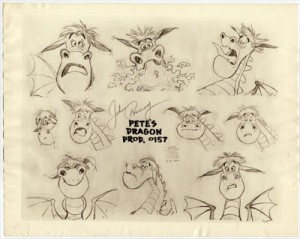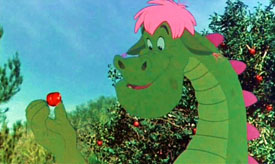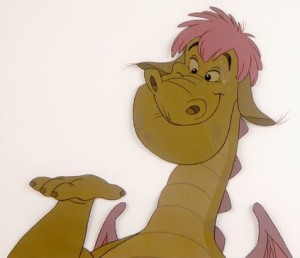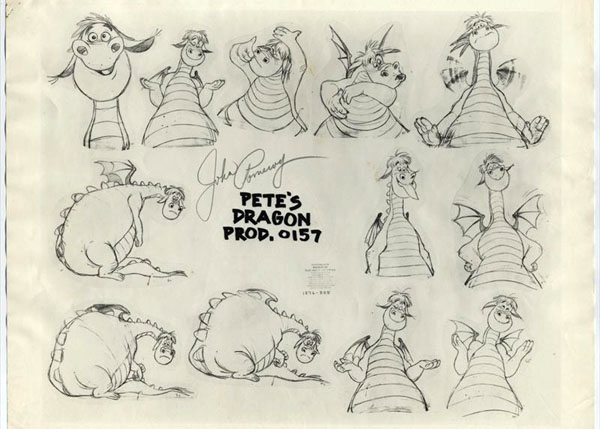
In August 2016, Disney will release its latest live-action “re-imagining” of one of its earlier films, the sentimental and sometimes misunderstood classic Disney movie, Pete’s Dragon (1977).
Walt Disney originally purchased the unpublished short story in 1957 as a possibility for his weekly television show.
 The story was about a boy named Pete who for various reasons had trouble dealing with reality and so would escape into a fantasy world. It would be up to the audience to decide if the dragon was real or a figment of Pete’s imagination because like the rabbit in the play and the movie Harvey only the consequences of actions were seen along with a logical possible explanation.
The story was about a boy named Pete who for various reasons had trouble dealing with reality and so would escape into a fantasy world. It would be up to the audience to decide if the dragon was real or a figment of Pete’s imagination because like the rabbit in the play and the movie Harvey only the consequences of actions were seen along with a logical possible explanation.
After Walt’s death, the Disney Studio rustled through some of the projects that Walt had been considering including ones that had been earmarked for the weekly television show and developed some of them into feature films like The Aristocats (1970) and Bedknobs and Broomsticks (1971).
In 1975 co-producer Jerome Courtland asked screenwriter Malcolm Marmorstein to adapt a screenplay from the story. Marmostein would later write Disney’s Return from Witch Mountain (1978).
At the time, there was going to be one short scene with an animated dragon but the animators convinced Ron Miller, then President of Walt Disney Productions, that the audience would feel cheated to see a film called Pete’s Dragon and only briefly see the creature. They argued that it should be expanded into a film with a combination of live action and animation like many of the successful films that Disney had done in the past.
 With the Sherman Brothers gone from the studio, Disney turned to Disney songwriters Al Kasha and Joel Hirschhorn to write a theme song for the film after their Oscar winning songs for the films The Poseidon Adventure (1972) and The Towering Inferno (1974).
With the Sherman Brothers gone from the studio, Disney turned to Disney songwriters Al Kasha and Joel Hirschhorn to write a theme song for the film after their Oscar winning songs for the films The Poseidon Adventure (1972) and The Towering Inferno (1974).
Cleverly, the pair wrote the song “Candle on the Water” as a tribute to their previous two Oscar winning songs, using the elements of water and fire (the candle) as “good luck”. When Disney management loved the song, they pitched that the film should be expanded into a musical and be the next Mary Poppins (1964).
During this process, the serious psychological tone of the original dissipated quickly although the final film still features child slavery, alcoholism, mourning for a lost love, the violence connected with superstition and more.
Disney Legend Ken Anderson joined the Disney Studios in 1934 and spent time as an animator, writer, art director and more including designing memorable characters like Shere Khan in The Jungle Book (1967). He also designed Elliott the dragon as his last contribution before his retirement in 1978.
 In the April 7, 1978 issue of the Studio Newsreel (Vol. 7, No. 14), the internal newsletter of the Disney Studios, Ken stated, “I don’t know how I came up with Elliott. I like to think of him as an example of China’s concept of the dragon as a symbol of luck and good will which came to them when they need him. He just came to me and I sure needed him!”
In the April 7, 1978 issue of the Studio Newsreel (Vol. 7, No. 14), the internal newsletter of the Disney Studios, Ken stated, “I don’t know how I came up with Elliott. I like to think of him as an example of China’s concept of the dragon as a symbol of luck and good will which came to them when they need him. He just came to me and I sure needed him!”
Vance Gerry and Pete Young boarded sequences of Pete’s Dragon with Ken.
Animator and director Don Bluth returned to the Disney Studio in April 1971 as part of a new training program to create a “new Nine Old Men” team. He was promoted to full animation director on Pete’s Dragon (1977) although the Disney Studio emphasized Anderson in its publicity so many thought he directed the animation.
During this period at Disney, Don met and formed a friendship with Gary Goldman and John Pomeroy who both did significant character animation work on Elliott.
Other new animators who worked on the film included Ron Clements, Glen Keane, Randy Cartwright, Dale Baer, Ed Gombert and even Don Hahn as an assistant animator. A total of eighty people worked on the animation in some capacity that was painstakingly drawn over large single frame blow-ups of the completed live action scenes, the same process later used for Who Framed Roger Rabbit (1988).
 There are scenes in the film where up to three scenes were composited together. So, there might be a live foreground and live background but there is a middle level where Elliott was doing things. Delays in the live action shooting delayed Bluth and his team getting the material they needed in a timely fashion.
There are scenes in the film where up to three scenes were composited together. So, there might be a live foreground and live background but there is a middle level where Elliott was doing things. Delays in the live action shooting delayed Bluth and his team getting the material they needed in a timely fashion.
It was not unusual for Bluth and the rest of the key animators to regularly work a hundred hours per week during the production to meet the deadline. Animator Gary Goldman commented in a studio press release at the time, “I remember towards the end of PETE’S working until 10:00 at night. Not even janitors were here [at the Disney studio].” Instead of being paid overtime, they were given compensation time after the production finished.
Originally, the animators were to create roughly 900 feet of animation on a $1.8 million budget. However, when management saw the first completed animation, they were so impressed that they demanded twice as much animation footage with no increase in budget or extended deadline.
Adding to the challenge of meeting the deadline was Bluth’s insistence that many of the cels in the film, including Elliot’s stomach and outline in key scenes, be hand-inked rather than Xeroxed as was the norm at the time so that the artwork would blend more organically with the live action.

Bluth met the impossible deadline but was reprimanded for going $75,000 over the assigned budget. The final film showcases approximately twenty-two minutes of animation with Elliott.
When Bluth left the Disney Studios in 1979 with Goldman and Pomeroy and eight others, he expressed how this incident was the beginning of him starting to think that Disney was no longer committed to quality in animation in a brief interview in the Pasadena Star-News newspaper: “Card (Walker, Disney CEO) had made an impossible deadline because he had already booked the picture into Radio City Music Hall. We worked until 9:00 every night to get the picture finished. The artists got no raises, not even any thanks. Then they read that Card and Ron (Miller) split $3 billion in bonuses. ‘What is this?’ the artists asked. I had no answers.”
In 1978, Variety listing the top grossing films of the previous year had Pete’s Dragon as number seventeen. Its initial release brought in eighteen million dollars which provided a decent profit over its eleven million investment (roughly $4.5 million dollars more than Mary Poppins) and some nice reviews but Disney was highly disappointed because it was hoping for a Mary Poppins-sized blockbuster in terms of revenue.
As a result, the film was cut from its original 134 minutes to 129 minutes during its initial run. A reissue appeared in 1984 that was edited further to just 106 minutes. For recent video releases, the film has been restored to close to its original length.
The ebullient animated dragon and his comical interactions with the live actors (especially the vaudeville styled antics of Mickey Rooney, Red Buttons and Jim Dale) still touches hearts but it remains to be seen if his CGI doppelganger will have the same effect.



 Jim Korkis is an internationally respected animation historian who in recent years has devoted his attention to the many worlds of Disney. He was a columnist for a variety of animation magazines. With his former writing partner, John Cawley, he authored several animation related books including The Encyclopedia of Cartoon Superstars, How to Create Animation, Cartoon Confidential and Get Animated’s Animation Art Buyer’s Guide. He taught animation classes at the Disney Institute in Florida as well as instructing classes on acting and animation history for Disney Feature Animation: Florida.
Jim Korkis is an internationally respected animation historian who in recent years has devoted his attention to the many worlds of Disney. He was a columnist for a variety of animation magazines. With his former writing partner, John Cawley, he authored several animation related books including The Encyclopedia of Cartoon Superstars, How to Create Animation, Cartoon Confidential and Get Animated’s Animation Art Buyer’s Guide. He taught animation classes at the Disney Institute in Florida as well as instructing classes on acting and animation history for Disney Feature Animation: Florida.




















































The original Pete’s Dragon took place in rural New England, according to sources including Wikipedia, the reboot of the film will be in the Pacific Northwest area (either Oregon,Washington State or Idaho) and the characters will be changed from a lighthouse keeper and his daughter replaced by a wood carver and his daughter who’s a forest ranger.
Passamaquoddy was the name of a real town in Maine, but it was a company town that only existed for a few decades, and it was not yet in existence in the time period in which the movie is set. My mother is from Maine, and she told me this bit of information after we watched “Pete’s Dragon” many years ago.
Odd thing about the original movie: A key element is Helen Reddy’s character refusing to believe in the dragon. But as the film plays out, EVERYBODY sees the dragon (or his impact on the buildings, etc.) and is thoroughly convinced long before she comes around; and even then she has to come fact to face with him. Instead of a cynic or pessimist denying something magical, she simply doesn’t accept an obvious reality.
Perhaps it all worked in the original script, but it got lost when they added scenes of Elliott visibly interacting with so many characters and sets. Much as “Harvey” would fall apart if an actual giant rabbit appeared and chatted with several characters.
I suspect something similar happened with “The Black Hole”, where an inexplicable sign of human behavior by robots was a huge plot point, but front and center we have totally sentient and emotional R2 knockoffs, speaking with the human voices of Roddy McDowell and Walter Brennan and accepted without question.
It was Slim Pickens, not Walter Brennan in “The Black Hole.”
“Pete’s Dragon” is a true classic of the later Disney era. There is a strong spiritual message built into it on the power of faith and hope. “Candle on the Water” is a hymn-like anthem which has a strong dimension of religious symbolism, reflective of “the Light of the World.” “There’s Room for Everyone in This World” is another song with a powerful message about inclusion. Elliot the Dragon can be viewed as a symbol of God’s miraculous answers to prayer, ultimately as the manifestation of the Holy Spirit. In an era when the Disney company was focusing its attention on almighty profits, it’s refreshing to find a film with such strong spiritual underpinnings. Besides that, it has a stellar cast and it is very funny, as well as being poignant and touching.
They left it wide open for a sequel at the end, has anyone noticed that?
It is interesting that you mentioned the religious undertones, not just Disney has become less comfortable with that since the 1990s (I recall reading they asked the Lopezes to say “Heaven” instead of “God” for “Let it Go”). Al Kasha and Joel Hirschhorn were Jewish, but Kasha converted to messianic Judaism a year after this film came out and later started a church where celebrities go to read the Bible; Gary Morgan, who played one of the Gogans, was also a messianic Jew. Incidentally, Helen Reddy had actually converted to Judaism when she married her ex-husband/manager Jeff Wald although she had been raised Protestant.
I have yet to see the original film but when I was a “cool” teen, I think I remember seeing Charlie Callas on The Mike Douglas show and that very clip. I got chills and warm- fuzzies watching that clip. That sequence still holds up technically and in warmth.
So is the old Pete’s Dragon available anywhere?
Since you’re Canadian, I’m not sure what serivces are available to you, but if know ‘a few tricks’, several venues like iTunes or YouTube has it available to watch if you must pay their petty sums.
https://youtu.be/iSyOzW3xCgM
There was a 35th anniversary Blu-Ray. It should still be in print. The picture is about as good as I have ever seen it look, and it seems this and the other hybrids escaped the excess DNR of some of the animated features of this era. I assume future releases will be affixed with “the original” from here on in as is the case with the originals of other late Walt-era/Ron Miller-era remakes/reboots. Whether they will ever try to see if it is possible to restore the original 134 minute cut is not something I’m optimistic about, if they couldn’t even make the 139-minute BEDKNOBS AND BROOMSTICKS an option on its Blu-ray. I wonder if the current managements’ desire to distance themselves from Miller and Bluth, who had nothing to do with either B&B or THE HAPPIEST MILLIONAIRE which both got restored to their uncut version in the 1990s.
But I recently discovered some good news on that front from the one place I never would have guessed. One of the things that was cut was the song “I Saw a Dragon.” The soundtrack album has these extra lyrics, and so does the published sheet music, but I’d never seen any actual film footage until now:
https://www.youtube.com/watch?v=X7e480d2cGE
It’s been issued a few times on DVD. The old “Gold Collection” edition included a 1974 featurette that feels a lot like an episode of the Sunday night show:
https://www.youtube.com/watch?v=Q72eI_EA4rc
The currently available version has some backstage materials, deleted songs and such.
There is a DVD release that has been out for several years and has been re-issued. I believe it is now available on Blu-Ray.
It’s an amazing movie–just don’t expect too much at the outset, and that way you will be surprised at its many delights. It’s not “practically perfect in every way” like Mary Poppins, but it’s still a lot of fun. (Jim Backus and Jane Kean, both brilliant performers, are given characters that are cartoony and stereotypical, which is a shame because they could have otherwise added some dimensionality to the film. Everyone else in my opinion does a creditable job, particularly Sean Marshall as Pete. He’s the real star of the film.)
You want the High Flying Edition on DVD, it’s 129 minutes long. The Blu-Ray is listed at 106 minutes.
smile.amazon.com/Petes-Dragon-High-Flying-Jim-Backus/dp/B002BIGCXS
For Canada the 128 minute Bilingual version is available at Amazon Canada
http://www.amazon.ca/Peter-Elliott-Dragon-Anniversaire-Anniversary/dp/B008EMQJJW
But I recently discovered some good news on that front from the one place I never would have guessed. One of the things that was cut was the song “I Saw a Dragon.” The soundtrack album has these extra lyrics, and so does the published sheet music, but I’d never seen any actual film footage until now:
https://www.youtube.com/watch?v=X7e480d2cGE
Noticing when this clip was added (last week) it couldn’t have came out at such a right time to use!
Jim Dale is probably best remembered for his performances in the “Carry On” films, and lately he is known for his reading of the Harry Potter audiobooks. Not only did Disney make good use of him here, but also in the Western spoof “Hot Lead and Cold Feet,” where he played multiple roles.
Pete’s Dragon is an underrated movie. It does pale in comparison to Mary Poppins, but it’s a great movie. My favorite songs from this movie are “Candle on the Water” and “Every Little Piece.” Let’s hope that the new remake will be good.
I recall the Televisa children’s show Odisea Burbujas (Bubbles Odyssey) used the overture from Pete’s Dragon as their incidental music for the show.
I don’t really want to be a downer, but does anyone else detest the big lower jawed character designs that Ken Anderson did on this and other movies? I think they’re the ugliest most unappealing characters I’ve ever seen in classic full animation.
I’ve never heard anyone else say anything bad about them, so I may be the only one who can’t stand them — but I wanted to say it at least once to see if anyone agreed with me.
I believe someone designed one of the characters in The Princess and the Frog with a large lower jaw as a tribute to these designs, which did not help me in trying to enjoy that movie!
Ok, rant over. I’ll only try to say nice things from now on!
No, no, I don’t.
The unproduced TV episodes were to have starred Kevin Corcoran, aka Moochie. They were planned as two parts for the 1958-59 season and would have been called “Pete’s Dragon and the USA”.
Bill, do you know if there was ever any concept art completed for the 58/59 TV episodes?
Side note:
My sister and I are HUGE Pete’s Dragon fans. Lincoln Mayorga, the pianist on the soundtrack (and a veteran session player), lives in our area – he would visit our school for the music program (which I never knew about until after the fact, bummer. Can you imagine having one of the musicians who worked on one of your favorite Disney movies come to play at your school??) — hell, I even watched a movie in which he was mentioned (The Wrecking Crew) with a few friends at a local arts theater. The only other people in the theater with us were an older couple. After we walked out, my friend informed me that the man was Mr. Mayorga! Always after the fact. Would love to shake his hand and thank him for all of the musical magic he helped to create. Not a clunker in this whole soundtrack — definitely underrated. And some fantastic, touching character animation (I do like his huge lower jaw design) — though it does veer into Bluthian territory (not my thing), it still has a very familiar Disney feel.
I’d also like to add that there are just some purely magical scenes in here. The way Elliott’s pink hair blows in the stormy breeze near the end scenes, the way he bounces and flutters his tiny pink wings, the way he catches a tear rolling down Pete’s cheek – combined with some beautifully simple piano interludes (Thanks, Mr. Mayorga!) that will sneak up on you and damn-near drive you to tears….or wicked laughter during the villains’ tunes…or to feel the bright sunshine and ocean breeze on your face as you paint your lighthouse. So it’s definitely a misunderstood/maligned solid chunk of cinematic fun, in my book — and with all of the work the animators put into it (the nitty-gritty of which I just learned about in this article), they definitely deserved more credit, by both Disney and the public. (Maybe Don Bluth wasn’t so bad after all…maybe I should give N.I.M.H. a try?) And some fine performances, all around – from Shelley Winters to Jim Dale, to Red Buttons to Helen Reddy – and of course, the incomparable Mickey Rooney as Lampy, the lovable drunkard. And Sean Marshall certainly has an undeniable charm, even if he is a little wet behind the ears. So many quotable lines of dialogue (do my best to refrain from spewing a slew of them here)…it goes on and on. In my opinion, any film we’ve gotten this much mileage out of over the years (even if it was just me and my sister — and I highly doubt we are the only ones) — can’t be bad. I sincerely hope we get the fully restored 134-min cut of the film one day.
PS Jim Dale is still alive and well – in addition to his aforementioned voiceover work, he puts on a very fine one-man show (according to my sister, who saw him at an Upstate NY venue), called ‘Just Jim Dale.’
Not to bring folks down, but trying to reboot a Disney animated film like “The Jungle Book” (the new live-action/CGI version coming out in mid-April) or the a live-action/animated musical like “Pete’s Dragon” (with Robert Redford replacing Mickey Rooney?!) is strictly a case of “not leaving well enough alone”… but don’t go by me!